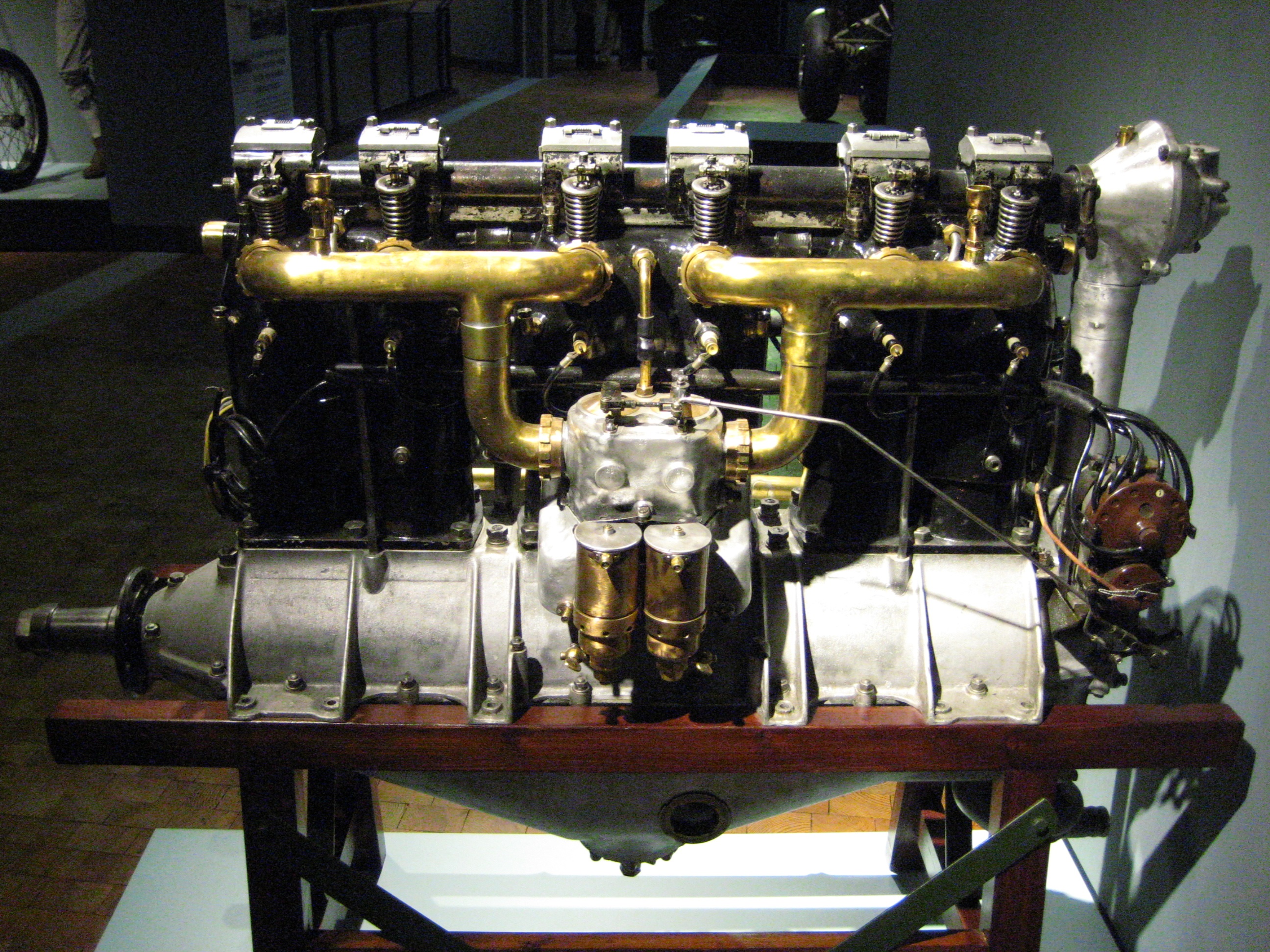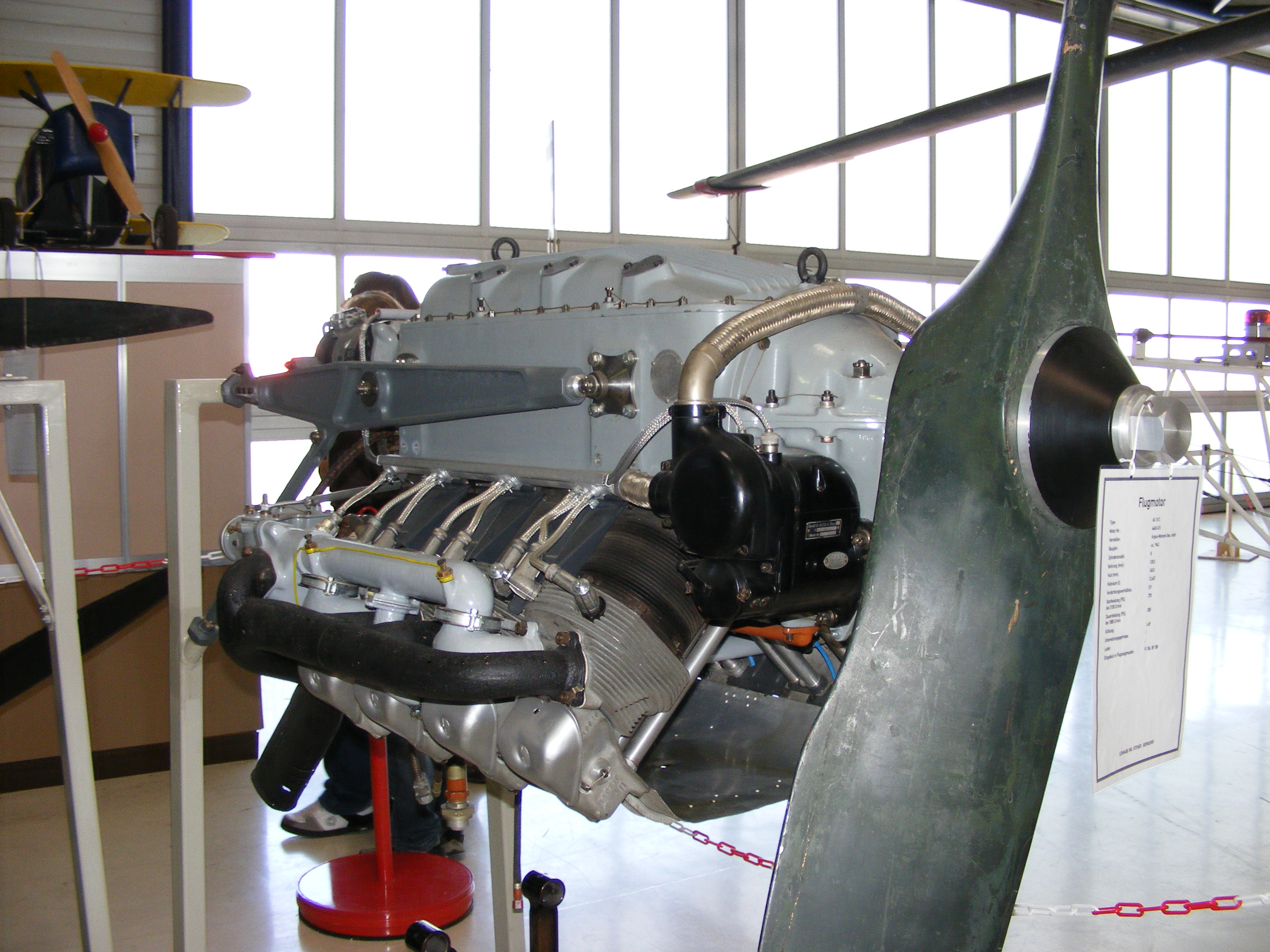Inline engine (aeronautics) on:
[Wikipedia]
[Google]
[Amazon]
 In
In
 ; O or Horizontally Opposed: Engines with two banks of cylinders arranged at 180° to each other driving a common crankshaft, almost universally mounted with banks horizontal for aircraft use, or with crankshaft vertical for helicopter use, (e.g. horizontally mounted Continental O-190, vertically mounted Franklin 6ACV-245).
; O or Horizontally Opposed: Engines with two banks of cylinders arranged at 180° to each other driving a common crankshaft, almost universally mounted with banks horizontal for aircraft use, or with crankshaft vertical for helicopter use, (e.g. horizontally mounted Continental O-190, vertically mounted Franklin 6ACV-245).
 ; W:Engines with three banks driving a common crankshaft, arranged so that first and last banks are 180°or less apart, (e.g. upright Lorraine 12Eb, inverted
; W:Engines with three banks driving a common crankshaft, arranged so that first and last banks are 180°or less apart, (e.g. upright Lorraine 12Eb, inverted  ;Fan: Engines with more than three banks with 180° or less between first and last bank, akin to W engines.
''Note:'' Fan engines with single cylinder banks, typically from Anzani, are usually regarded as variants of the
;Fan: Engines with more than three banks with 180° or less between first and last bank, akin to W engines.
''Note:'' Fan engines with single cylinder banks, typically from Anzani, are usually regarded as variants of the  ; U:Engines with two banks of cylinders side by side driving separate crankshafts geared to a single output, (e.g.
; U:Engines with two banks of cylinders side by side driving separate crankshafts geared to a single output, (e.g.  : Inline Radial: Multiple bank engines, usually liquid-cooled, with an odd number of banks (three or more) arranged around a common axis and/or driving a common crankshaft with more than 180° between first and last banks, (e.g. air-cooled Armstrong Siddeley Deerhound, liquid-cooled BMW 803).
''Note'' The BMW 803 is not only an inline radial engine but is also a coupled engine with two engines arranged back to back on a common axis driving separate co-axial propellers through a common gearbox.
: Inline Radial: Multiple bank engines, usually liquid-cooled, with an odd number of banks (three or more) arranged around a common axis and/or driving a common crankshaft with more than 180° between first and last banks, (e.g. air-cooled Armstrong Siddeley Deerhound, liquid-cooled BMW 803).
''Note'' The BMW 803 is not only an inline radial engine but is also a coupled engine with two engines arranged back to back on a common axis driving separate co-axial propellers through a common gearbox.
 An upright engine has the cylinder heads directly above the crankshaft. By contrast an inverted engine has the cylinder heads directly beneath it. In the inverted V layout, the cylinders angle downwards instead of upwards.
For an aero engine, advantages of the inverted layout include improved access to cylinder heads and manifolds for the ground crew, having the centre of mass of a multi-bank engine lower in the engine and, for engines mounted in the nose, improved visibility for the pilot and placing the widest part of a multi-bank engine closer to the midline of the fuselage, which is typically its widest point.
The Hirth HM 60 four-cylinder inverted inline engine was introduced in 1924, and inverted designs saw increasing popularity through the late 1920s and 30s. Widespread examples included the inline de Havilland Gipsy Major used in the de Havilland Tiger Moth, and the inverted-V Daimler-Benz DB 601 used in the
An upright engine has the cylinder heads directly above the crankshaft. By contrast an inverted engine has the cylinder heads directly beneath it. In the inverted V layout, the cylinders angle downwards instead of upwards.
For an aero engine, advantages of the inverted layout include improved access to cylinder heads and manifolds for the ground crew, having the centre of mass of a multi-bank engine lower in the engine and, for engines mounted in the nose, improved visibility for the pilot and placing the widest part of a multi-bank engine closer to the midline of the fuselage, which is typically its widest point.
The Hirth HM 60 four-cylinder inverted inline engine was introduced in 1924, and inverted designs saw increasing popularity through the late 1920s and 30s. Widespread examples included the inline de Havilland Gipsy Major used in the de Havilland Tiger Moth, and the inverted-V Daimler-Benz DB 601 used in the
 In
In aviation
Aviation includes the activities surrounding mechanical flight and the aircraft industry. ''Aircraft'' includes fixed-wing and rotary-wing types, morphable wings, wing-less lifting bodies, as well as lighter-than-air craft such as hot ...
, an inline engine is a reciprocating engine
A reciprocating engine, also often known as a piston engine, is typically a heat engine that uses one or more reciprocating pistons to convert high temperature and high pressure into a rotating motion. This article describes the common fea ...
with bank
A bank is a financial institution that accepts deposits from the public and creates a demand deposit while simultaneously making loans. Lending activities can be directly performed by the bank or indirectly through capital markets.
Becau ...
s of cylinders, one behind another, rather than rows of cylinders, with each bank having any number of cylinders, although more than six is uncommon. The major reciprocating-engine alternative configuration is the radial engine
The radial engine is a reciprocating type internal combustion engine configuration in which the cylinders "radiate" outward from a central crankcase like the spokes of a wheel. It resembles a stylized star when viewed from the front, and is ...
, where the cylinders are placed in a circular or "star" arrangement.
The term "inline" is used somewhat differently for aircraft engines than automotive engines. For automotive engines, the term ‘inline’ refers only to straight engines (those with a single bank of cylinders). But for aircraft, ‘inline’ can also refer to engines which are not of the straight configuration, such as V, H, or horizontally opposed.
Inline engine configurations
; Straight: Engines with a single bank of cylinders which can be arranged at any angle but typically upright or inverted, (e.g. upright ADC Cirrus, inverted de Havilland Gipsy Major). ; V:Engines with two banks of cylinders with less than 180° between them driving a common crankshaft, typically arranged upright or inverted (e.g. upright Liberty L-12, inverted Argus As 410). ; O or Horizontally Opposed: Engines with two banks of cylinders arranged at 180° to each other driving a common crankshaft, almost universally mounted with banks horizontal for aircraft use, or with crankshaft vertical for helicopter use, (e.g. horizontally mounted Continental O-190, vertically mounted Franklin 6ACV-245).
; O or Horizontally Opposed: Engines with two banks of cylinders arranged at 180° to each other driving a common crankshaft, almost universally mounted with banks horizontal for aircraft use, or with crankshaft vertical for helicopter use, (e.g. horizontally mounted Continental O-190, vertically mounted Franklin 6ACV-245).
Napier Lioness
The Napier Lion is a 12-cylinder, petrol-fueled 'broad arrow' W12 configuration aircraft engine built by D. Napier & Son from 1917 until the 1930s. A number of advanced features made it the most powerful engine of its day and kept it in produ ...
).
; X: Multiple bank engines with four banks arranged around a common crankshaft, usually spaced evenly, (e.g. evenly spaced Rolls-Royce Vulture
The Rolls-Royce Vulture was a British aero engine developed shortly before World War II that was designed and built by Rolls-Royce Limited. The Vulture used the unusual " X-24" configuration, whereby four cylinder blocks derived from the Ro ...
, unevenly spaced Napier Cub).
Radial engine
The radial engine is a reciprocating type internal combustion engine configuration in which the cylinders "radiate" outward from a central crankcase like the spokes of a wheel. It resembles a stylized star when viewed from the front, and is ...
.
 ; U:Engines with two banks of cylinders side by side driving separate crankshafts geared to a single output, (e.g.
; U:Engines with two banks of cylinders side by side driving separate crankshafts geared to a single output, (e.g. Bugatti U-16
The Bugatti U-16 was a 16-cylinder water-cooled double-8 vertical in-line " U engine", designed by Ettore Bugatti in 1915-1916 and built in France in small numbers. The US Bolling Commission bought a license to build the engine in the US, and ...
).
; H:Engines with four banks of cylinders driving two crankshafts geared to a single output, in effect, two Opposed engines coupled together and mounted either horizontally or vertically, (e.g. horizontally Napier Sabre, vertically Napier Dagger).
; Opposed piston:Two-stroke engines, typically compression ignition/Diesel, with a single bank of cylinders driving two crankshafts where the pistons travel towards each other forming single combustion chambers, (e.g. Jumo 207).
:Deltic: Engines with three banks of opposed piston cylinders arranged in a triangle with three crankshafts geared to drive a single output,(e.g. Napier Deltic)
:Rhomboidal: Engines with four or more banks of opposed piston cylinders arranged in a square with four crankshafts geared to drive a single output,(e.g. Jumo 223
The Junkers Jumo 223 was an experimental 24-cylinder aircraft engine based on the Junkers Jumo 205. Like the Jumo 205, it was an opposed piston two-stroke diesel engine. It had four banks of six cylinders in a rhomboid configuration, with four ...
)
''Note:'' There is no theoretical limit to the number banks in an opposed piston engine, limitations include cost, complexity and reliability.
;Multiple bank:Engines with more than two banks, arranged around a common axis and/or crankshaft with more than 180° between first and last banks.
:Star: Multiple bank engines with an even number of banks (more than four) arranged around a common axis and/or driving a common crankshaft with more than 180° between first and last banks, (e.g. Jumo 222, Dobrynin VD-4K).
Inverted engine
Messerschmitt Bf 109
The Messerschmitt Bf 109 is a German World War II fighter aircraft that was, along with the Focke-Wulf Fw 190, the backbone of the Luftwaffe's fighter force. The Bf 109 first saw operational service in 1937 during the Spanish Civil War an ...
.
References
Citations Bibliography * * {{refend Piston engine configurations Aircraft piston engines